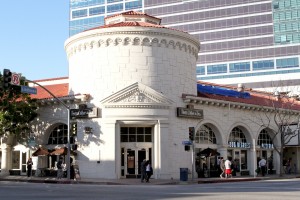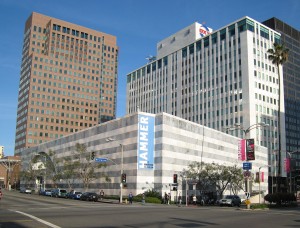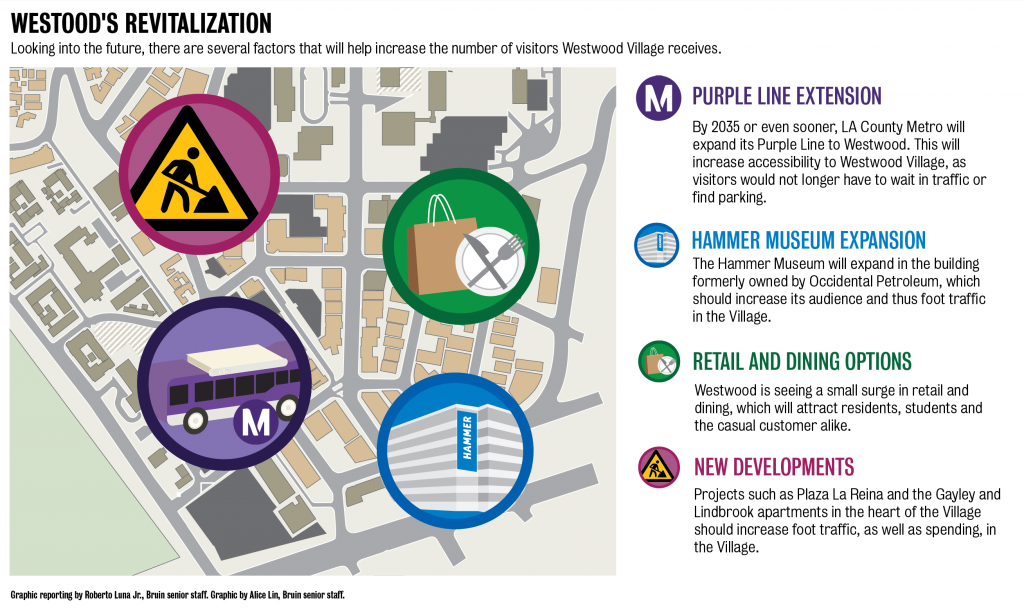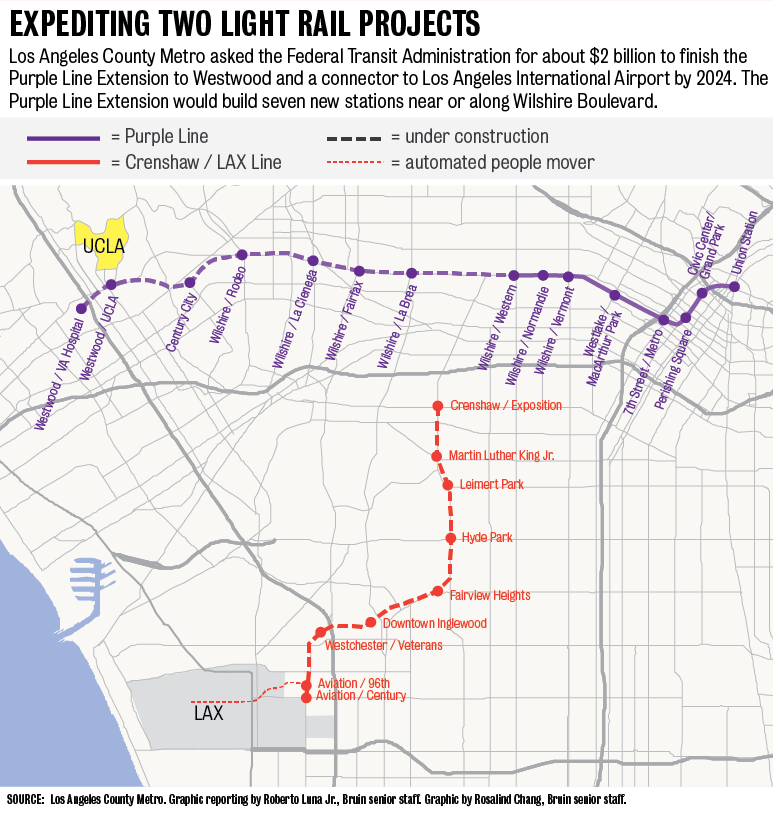Editor’s note: Is a long slump over for the Village? We conclude the Quad’s series on Westwood’s rise, decline and future by focusing on the last bit.
The concept of “bringing Westwood back” has been used so many times, it has become a cliché.
That is because since the 1980s, many revitalization efforts have been unsuccessful in bringing Westwood Village back to its former glory. These efforts include a specific plan, a business improvement district that went bankrupt and many, many failed businesses.
But as we near the end of 2015, the landscape has changed. Business owners, new developers and residents are aiming to carry Westwood into a new direction.
For the last 15 years, Westwood has seen a surge in development that could change its image drastically. From the increase of retail options to mixed-use projects, more people will be in Westwood spending more money over the next few years.
Here are the signs that show a revitalization in Westwood is imminent.
More retail options
When stores come to Westwood, one should consider what value they will add. Landlords as well as potential business owners should consider what Westwood needs, or what it lacks. Ignoring this allows too many of one kind of store to open up, a problem that arose in the 1980s.
The problem has since returned, and that’s why the Westwood Village Specific Plan should play a key role. What’s the point of having 12 restaurants that serve pizza and about as many that serve sandwiches? The plan can help increase variety in the Village by setting a limit on restaurant types. It makes for better business. If you have the only Mexican or Indian food restaurant in the area, then you’ll have a large clientele waiting.

Store diversity is not only good for owners, but also for consumers.
For over 20 years, there wasn’t a supermarket in Westwood. Hard to believe, but students and mainly residents had to go out of Westwood to shop for groceries. Then Ralphs decided to reopen a location on Le Conte Avenue in 2001, closing the gap. Since then, Trader Joe’s and Whole Foods Market have opened and been successful.
Target filled the spot of a department store in Westwood when it opened in 2012.
New stores and restaurants are also coming into Westwood, and this can show other potential businesses that it is a safe market. More stores have opened in the second half of 2015 than have closed. From Francesca’s and Paper Source’s arrival this year to Sur La Table’s announcement, we are seeing more exclusive and convenient retail showing up.
These new stores should cater to both students and residents, so that they won’t have to travel to another shopping center or across town to get what they need. A bookstore, for example, will appeal to students, as well as residents and other people in the area.
Again, the idea of filling the gaps currently present in the Westwood market can be the key to a successful business.
New developments
Mixed-use projects right in the Village will not only add more foot traffic, but also more consumer spending. That is because these projects are aimed at high-income residents.
Upper-class individuals can now consider living at the Gayley and Lindbrook Apartments, a 34-unit mixed-use project. A 45-room extended-stay hotel, Plaza La Reina, will cater to international visitors and tourists when it opens this month. Both projects will have restaurants on their ground floors.
As it looks forward with making higher-end buildings, Westwood should also continue to maintain its older buildings with the historic architecture that once helped it thrive. These buildings, distinctly Mediterranean in appearance, can make Westwood stand out in the modern era.
The Kinross and Gayley building restoration, for example is expected to have a higher leasing quality after a $1 million renovation.
Taking this into consideration, these projects won’t have much of an impact if some spots in the Village are not well-maintained. Westwood is going to feel unevenly developed if there is a worn-out dome building on one side of a street and a multi-million dollar hotel on the other. Westwood needs consistent development and revitalization across all corners if it wants to be successful.
The Purple Line
The Purple Line extension to Westwood from its current terminus in Koreatown will increase accessibility and the number of visitors to the village. It would allow riders to go from downtown Los Angeles to Westwood in 30 minutes or less – that is the dream for transit obsessives like myself.
The project is expected to be completed by 2035. However, if Los Angeles were to win the bid for the 2024 Summer Olympics, city officials would seek additional funding to finish the project before the event.
L.A. County Metro officials said finishing the extension earlier will reduce construction costs, cause less traffic impacts and be convenient for the 150,000 people that work around the planned train stations.
The Village has had a lack of parking recently, something that has dissuaded people from visiting. Having a subway at its doorstep would make Westwood more accessible for hundreds of thousands of people.
The Hammer Museum

Lastly, the Hammer Museum’s recently announced expansion will only add more foot traffic to the Village.
The free museum, now a popular tourist attraction with an annual attendance of nearly 200,000, will expand to take up the first five floors of the building formerly owned by Occidental Petroleum.
Even though UCLA has been managing the museum since 1994, it is more independent than other museums funded by universities. Even then, the Hammer Museum has become a respected museum since UCLA took over.
When Armand Hammer, former chairman of Occidental Petroleum, founded the museum, people envisioned Westwood becoming an arts and culture center. Though that may not be completely true today, the museum has a lot of potential. It already has hosted critically acclaimed exhibitions and has a large following, so an expansion will certainly draw more crowds.
Looking at the future
I love looking at old photos of Westwood, imagining myself in them and then comparing them to the present. And every time, I am astonished to see how much the Village has changed. Whenever I walk by Wilshire and Westwood, I tried to imagine the dirt roads they once used to be, long before the Oppenheimer Tower was built.
Waxing nostalgic is only fun up to a certain point, and so I begin to think about what Westwood can be. I envision crowded streets at night, plentiful store options, new buildings and a clock tower that actually works. And I think this vision, given the signs, may become true very soon.


